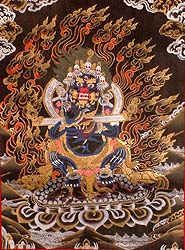 We all possess behavioral potentials that are consonant with our sense of self — and potentials that are buried, rejected, submerged, or disowned. The energy of those submerged or disowned potentials is cut off and unavailable to our personality. The more potentials we disown, the more narrow our range of adaptation and the more enervated and weakened we become. The more we attempt to perfect ourselves and live according to some idealized image, the more cut off and depleted we become due to the loss of rejected potentials that fail to fit the image. Attempting to live up to some sort of Buddhist ideal of perfection — serene, non-grasping, imperturbable, endlessly compassionate — is one way to choke off our sources of vitality. We cut ourselves off from a wide range of human potentials — ferocity, passion, lust, and ambition, just to name a few. An inherent tension exists between Buddhist teachings of perfecting ourselves by striving to live up to a Bodhisattva or Arhat ideal and the contemporary Western Zen notion of being present for all of life.
We all possess behavioral potentials that are consonant with our sense of self — and potentials that are buried, rejected, submerged, or disowned. The energy of those submerged or disowned potentials is cut off and unavailable to our personality. The more potentials we disown, the more narrow our range of adaptation and the more enervated and weakened we become. The more we attempt to perfect ourselves and live according to some idealized image, the more cut off and depleted we become due to the loss of rejected potentials that fail to fit the image. Attempting to live up to some sort of Buddhist ideal of perfection — serene, non-grasping, imperturbable, endlessly compassionate — is one way to choke off our sources of vitality. We cut ourselves off from a wide range of human potentials — ferocity, passion, lust, and ambition, just to name a few. An inherent tension exists between Buddhist teachings of perfecting ourselves by striving to live up to a Bodhisattva or Arhat ideal and the contemporary Western Zen notion of being present for all of life.
When we examine the ideal of non-grasping serenity, the first thing we notice is how far we are from it. Most of our thoughts are centered on ourselves and the things we want or don’t want, and selfish thoughts and impulses vastly outnumber generous ones. Ambition, greed, desire, jealousy, resentment, irritation, and anger are frequent companions. The Pali Canon says if we follow the eight-fold path we can reach a state where all of that simply ceases — where desire, aversion, and delusion stop arising — the original meaning of the word ”nirvana”. When we observe the gap between the way we are and this imagined end-state, we’re as far from that end-state as we can possibly be. We may also wonder just how desirable that imagined end-state actually is. Do we really want to be that seemingly bloodless, endlessly calm, desire-less being? Or do we just want to be more human, vulnerable, open, and alive?
Compare the Nirvana ideal to the life Jelaluddin Rumi (1207-1273) recommends in his poem ”The Guest House”:
This being human is a guest house.
Every morning a new arrival.
A joy, a depression, a meanness,
Some momentary awareness comes
As an unexpected visitor.
Welcome and entertain them all!
Even if they’re a crowd of sorrows,
who violently sweep your house
empty of its furniture,
Still, treat each guest honorably.
He may be clearing you out for a new delight.
The dark thought, the shame, the malice,
meet them at the door laughing,
and invite them in.
Be grateful for whoever comes,
Because each has been sent
As a guide from beyond.
(Translation by Coleman Barks)
Rumi’s Guest House metaphor offers a Sufi parallel to the contemporary Western Zen ideal of Zen as a continual opening, widening, and acceptance of life as it is. As we sit we create a space for our full human being — no cutting off, suppression, or delusion about who or what we are in this moment.
How does the Zen ideal of fullness of being square with the aspirational aspects of Buddhism — the Bodhisattva vows — the widening of compassion, lovingkindness, and equanimity? Because a part of us would truly like to be more compassionate and kind — to the extent this cruel and capricious life allows us to be. Buddhism contains a variety of techniques like Theravada lovingkindness meditations and Tibetan tonglen meditations to help us develop our capacity for compassion and lovingkindness. Can one widen one’s capacity for care for others without choking off the sources of one’s vitality?
We can if we stop pretending to live up to an ideal.
One can water the seeds of compassion without pretending to be more compassionate than one actually is. One can hope over time that compassion will grow without denying that ambitious, competitive, and aggressive parts of ourselves exist and are an important part of who we are right now. We can also do more than ruefully accept their continued existence, but develop a friendly ongoing relationship with them. We are not trying to eliminate them, but to integrate them in with the other parts of ourselves — to, in essence, tame them and harness their energy for higher purposes — much like the fierce Tibetan protective deities were tamed by Padmasambhava and enlisted to serve the Dharma. We have this idea in the West as well — Freud called it ”sublimation,” Jung called it ”individuation,” and Perls called it ”being whole.”
On one of my early ten-day meditation retreats, I had the following experience: The more calm, serene, and peaceful I became during the day, the more violent my dreams became at night. Not only were the dreams violent, but I was the perpetrator and I was enjoying it. It was if a part of me was reminding me ”I’m still here, don’t forget me.” On yet another meditation retreat I became paranoid about a fellow yogi — fearful he was a serial killer and I was his next intended victim. I’ve written elsewhere about how I overcame that fear, but it occurs to me now that this was another message about how I was disowning a part of myself — this other yogi was the container for my own projected aggressive capacity. Two retreats, the same message.
American Buddhist teachers have a name for aspiring to be ”spiritual” without really working through and integrating all of oneself to achieve a genuine reorganization of the personality at a higher level. They call it ”spiritual bypassing” — the attempt to take a short cut on the Enlightenment Superhighway. It’s a good word. We live in a world with the sky above and the mud below. While we may reach for the stars, we’re grounded in the earth. Like Prospero in Shakespeare’s Tempest, our inner world contains both Ariel and Caliban — the airy sprite and the chthonic mooncalf. We move forward by integrating opposites, not by embodying one while denying the other. We must honor not only the Sky God, but the Earth Mother as well.
This is an aspiration to a wholeness in which nothing is left out. We move forward in the world with all our capacities, all of our energy, all of our engagement, and all of our complexities and contradictions.
As we practice Buddhism, let’s take care. Let’s not put ourselves on a Procrustean bed. We don’t need to kill our egos or deny our true being. We don’t need to magically become the epitome of an imagined perfect Buddhist — calm, selfless, inhuman. We bring our whole selves to practice. It’s our gift to the Dharma. It’s the way we transform ourselves by becoming who we more truly are — only a better, deeper, more whole version of that self we imagine ourselves to be.
